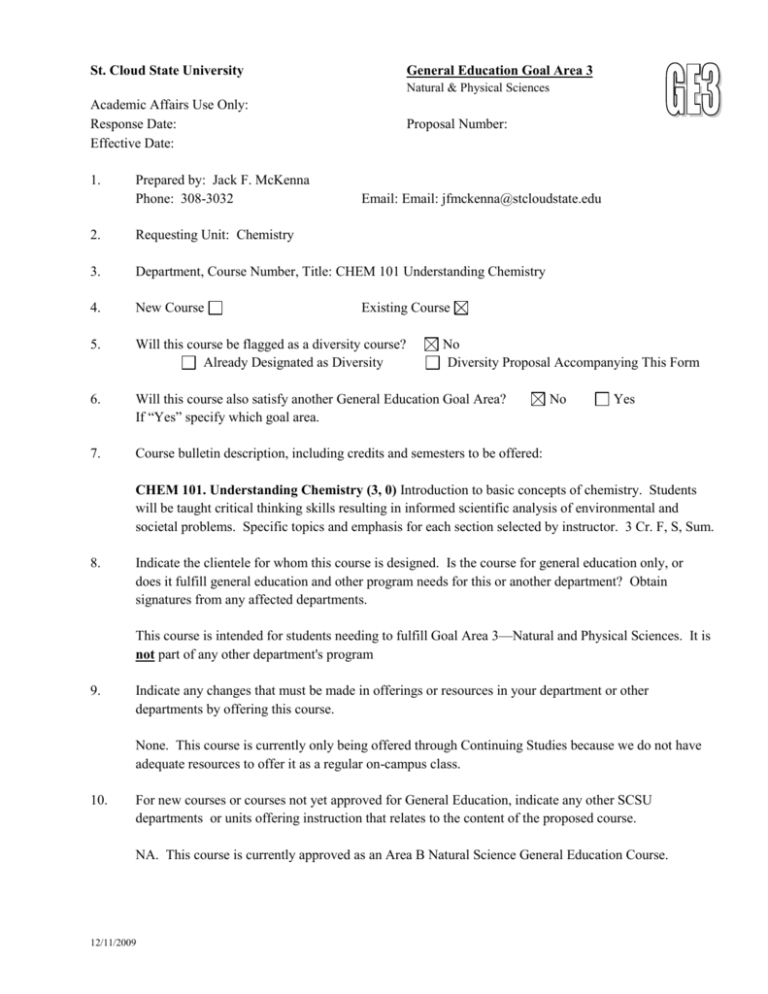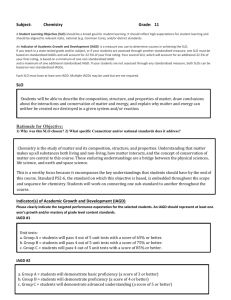St. Cloud State University General Education Goal Area 3 Natural
advertisement

St. Cloud State University General Education Goal Area 3 Natural & Physical Sciences Academic Affairs Use Only: Response Date: Effective Date: 1. Prepared by: Jack F. McKenna Phone: 308-3032 Proposal Number: Email: Email: jfmckenna@stcloudstate.edu 2. Requesting Unit: Chemistry 3. Department, Course Number, Title: CHEM 101 Understanding Chemistry 4. New Course 5. Will this course be flagged as a diversity course? Already Designated as Diversity 6. Will this course also satisfy another General Education Goal Area? If “Yes” specify which goal area. 7. Course bulletin description, including credits and semesters to be offered: Existing Course No Diversity Proposal Accompanying This Form No Yes CHEM 101. Understanding Chemistry (3, 0) Introduction to basic concepts of chemistry. Students will be taught critical thinking skills resulting in informed scientific analysis of environmental and societal problems. Specific topics and emphasis for each section selected by instructor. 3 Cr. F, S, Sum. 8. Indicate the clientele for whom this course is designed. Is the course for general education only, or does it fulfill general education and other program needs for this or another department? Obtain signatures from any affected departments. This course is intended for students needing to fulfill Goal Area 3—Natural and Physical Sciences. It is not part of any other department's program 9. Indicate any changes that must be made in offerings or resources in your department or other departments by offering this course. None. This course is currently only being offered through Continuing Studies because we do not have adequate resources to offer it as a regular on-campus class. 10. For new courses or courses not yet approved for General Education, indicate any other SCSU departments or units offering instruction that relates to the content of the proposed course. NA. This course is currently approved as an Area B Natural Science General Education Course. 12/11/2009 11. Courses designated as General Education are included in the assessment plan for the Goal Area(s) for which they are approved. Courses for which assessment is not included in the annual GE assessment report for two years will be removed from the General Education Program. The Requesting Unit understands and recognizes the above conditions. 13. Provide a concise explanation of how the following goal is a “significant focus” of the proposed course. Goal Area 3: Natural & Physical Sciences Explore scientific knowledge of the natural world. Understand the central concepts and principles of science; experience the process of scientific inquiry; comprehend science as a human endeavor and understand the impact of science on individuals and on society. Our understanding of the natural world begins with observation. Our attempt to explain our observations begins with the Scientific Method where a testable hypothesis is formulated. Testing our hypothesis by experimentation leads to results that either reinforce our hypothesis or force us to modify or reject our hypothesis. The interplay between hypothesis formation and experimentation is the foundation for the accumulation of scientific knowledge of the natural world. Through this course, students will see how scientific knowledge is acquired. In this course students will be exposed to many of the central concepts and principles of chemistry such as the Law of Conservation of Mass, the Law of Multiple Proportions, the Law of Definite Proportions, Rutherford's Nuclear Model of the Atom, Dalton's Atomic Theory as well as others. Students will demonstrate their understanding of these concepts and principles through their application and through calculation. Since this course is not intended as a lab course but rather provide a lab-like experience, students will be exposed to the process of scientific inquiry from a historical perspective as well as completing several experiments where the data is provided and the student will have to perform the necessary calculations and explain the results. Science by its very nature is a human endeavor because the scientific method requires human participation. However, until recently, science has been taught with little regard to the people who performed the research. In this course a significant amount of material is devoted to the scientists themselves in order to show that science is a process that is performed by individuals. Additionally, topics such as nuclear waste, air and water pollution, and global warming illustrate the impact science has on individuals and on society. 14. In order for a course to be designated as fulfilling Goal Area 3, it must address at least 5 of the 6 student learning outcomes (SLOs) below. Check the SLOs below that are focused on in the proposed general education course. 1. Demonstrate knowledge of concepts, principles, and theories in the physical or natural sciences. 2. Make observations and collect data, design and carry out experiments or other types of scientific investigations. 3. Formulate research questions and testable hypotheses, analyze and interpret data, draw inferences and conclusions, and identify further questions for investigation. 4. Demonstrate awareness of the interdependent relationships of basic science, applied science, mathematics, and technology. 5. Recognize the human nature of the scientific enterprise, including the importance of curiosity, creativity, and imagination; the dual nature of scientific knowledge as changeable and durable; and the impact of a scientist's personal identity on the scientific process. 6. Evaluate societal issues from a science perspective, question the evidence presented, and make informed judgments about these issues. 12/11/2009 15. Discuss how each Student Learning Outcome checked above is achieved in this course. (Note: Although descriptions of typical assignments or types of assignments may be part of this discussion, it is not appropriate to submit copies of actual assignments.) 1. One of the central concepts of chemistry is the concept of the atom. From the concept of the atom, Dalton's Atomic Theory and by application of the Scientific Method, it is possible to verify the Law of Conservation of Mass, the Law of Definite Proportions, and the Law of Multiple Proportions. Together, these basic laws of chemistry lead to applications of balanced chemical reactions and stoichiometry (mass relationships). Students will demonstrate their learning and satisfy this Student Learning Outcome by applying each of these fundamental principles through problem solving, multiple choice questions and brief short answer responses. This assessment is done through exams and online homework assignments. The list of concepts, principles and theories given here is only a subset of the content of this course and is only intended as an example. A detailed course outline lists the other concepts, principles and theories covered in this course. 2. This course has no formal lab experience—it includes a lab-like experience. 3. Many of the lab-like experiments will require students to formulate a testable hypothesis. In one experiment, students will be given a table of lattice energies for a series of salts. Students will then make a hypothesis about the heat effects for the dissolution of these salts in water. Data will be provided for the dissolution of these salts in water that will need to be analyzed and interpreted by the students. The results will then lead the student to reinforce or require the modification/rejection of the original hypothesis. Conclusions will need to be drawn and the students will formulate hypotheses for possible further experiments. Essentially, the student will conduct all of the parts of an experiment except the actual physical collection of data. The process of formulating hypotheses, analyzing data, formulating conclusions and identifying questions for further research is central to the process of science and chemistry in particular. A minimum of six lab-like experiments will be conducted. Additionally, students will be required to demonstrate their understanding of some of the elements of the scientific method through exams and online homework assignments. 4. An example of one of the several ways that this SLO is met by students can be found in the chapter on Nuclear Chemistry. The development of nuclear weapons clearly demonstrates one of several examples of the interdependent relationships of basic science, applied science, mathematics and technology. The development of the atomic bomb began in 1939 with Otto Hahn whose basic science experiment demonstrated the fission of the atom. This was followed by mathematical computations that showed the possibility of a self-sustaining nuclear chain reaction that was quickly followed by Enrico Fermi building the first nuclear 'pile' at the University of Chicago. With the application of large amounts of cash and enormous human resources, the first nuclear detonation occurred on July 16, 1945. Students will be required to demonstrate their understanding of the interdependent relationships through the use of mathematics in solving problems and by explaining how technology affects basic science and conversely how basic science affects technology. A list of topics where students will be required to demonstrate the interdependent nature of basic science, applied science, mathematics and technology include acid rain, global warming, ozone depletion, air and water pollution, and genetic engineering. Learning will also be assessed through online homework and through examinations. 5. Curiosity, creativity, and imagination have always played a significant role in chemistry. By using case studies, it is possible to demonstrate how this Student Learning Outcome is achieved. In the 1960s, Barnett Rosenberg at Michigan State University was passing an electric current through Escherichia coli (E. coli) bacteria when he noticed that the cells immediately surrounding one of the electrodes were killed. His original hypothesis was that the application of small currents would accelerate the growth of cells so this result contradicted his hypothesis. His curiosity caused him to theorize that the inhibition of binary fission in the cells must be due to a platinum compound from the platinum electrodes. Since cancer is uncontrolled cell growth, he conducted a series of experiments to test the effects of various platinum coordination complexes on sarcomas artificially 12/11/2009 implanted in rats. He found that cis-PtCl2(NH3)2 was the most effective at killing the cancer cells and cisplatin became one of the most successful anticancer drugs of all time. Thus a study aimed at increasing growth rates to speed healing led to a drug that is extremely effective at killing cancer cells. Students will be required to demonstrate their understanding of the human nature of the scientific enterprise by explaining how creativity, curiosity, and imagination have impacted chemistry. Students will also demonstrate their understanding of how scientists themselves affect the process of science. Learning will be assessed through the dissection of case studies as well as through online homework and through examinations. Science by its very nature is tentative—all scientific knowledge can be shown to be false by new information/experimentation—this is the concept of falsifiability. Students will need to be able to explain the concept of falsifiability and use it to distinguish between science and non-science. The history of science is littered with theories that have been discarded based on new information. As a case in point, we no longer teach students that the sun revolves around the earth or that the earth is flat—both of which were widely accepted as being true but are now known to be false. Often simply because of a lack of time we do not show all of the dead ends and discarded theories; thus students sometimes get the incorrect idea that scientists never are wrong. As a result, it is important to show that several theories in chemistry have been discarded because they do not fit the data. In one example, students will examine the Phlogiston theory of combustion and use data from Lavoisier to show that it does not fit the data and has to be discarded. Students will demonstrate learning by being able to discard theories on the basis of experimental data. Students will also demonstrate the tentative nature of science in SLO 3 in the refinement of hypotheses on the basis of experimental data. 6. 16. Chemistry provides several examples where we can look at societal issues from a science perspective. One of the famous quotes from Dr. Robert Oppenheimer, the scientific director of the Manhattan Project: "When you see something technically sweet, you go ahead and do it and you argue about what to do about it only after you have had your technical successes." After visiting the bomb sites in Hiroshima and Nagasaki, Dr. Oppenheimer worked for the rest of his life as an opponent to nuclear weapons eventually leading to the loss of his security clearance. The issue of nuclear power, nuclear waste, and nuclear weapons all evoke strong opinions from students. Through gaining basic scientific information about nuclear chemistry, students will evaluate scientific evidence and make reasoned arguments about nuclear weapons, nuclear power, and nuclear waste. Students will demonstrate also their understanding by articulating arguments, either for or against, several additional topics such as acid rain, global warming, ozone depletion, air and water pollution, and genetic engineering. Courses satisfying Goal Area 3: Natural & Physical Sciences must have either a “traditional lab course or a lab-like experience”. Check which of these apply and supply a brief explanation of how the course is either a laboratory course or incorporates a “lab-like experience”. Course includes: Laboratory Lab-like experience The following quote from a National Research Council subcommittee report may help to identify a course with a laboratory. ”Laboratory experiences provide opportunities for students to interact directly with the material world (or with data drawn from the material world), using the tools, data collection techniques, models, and theories of science.” America's Lab Report: Investigations in High School Science (Free Executive Summary) http://www.nap.edu/catalog/11311.html This course will include lab-like experiences dealing with topics including: The Scientific Method, Density, Accuracy and Precision, Stoichiometry, Nomenclature, Significant Figures, Bonding, Lewis Formulas, Limiting Reactants, Gas Laws, Acids and Bases, Thermochemistry, Nuclear Chemistry, Molecular Geometry (VSEPR Theory), The Nuclear Model of an Atom (Rutherford's Gold Foil experiment) as well as others. 17. List or attach the Course Outline (adequately described and including percentage of time to be allocated to each topic). Curriculum Committees may request additional information. Topics larger than 20% need 12/11/2009 to be broken down further. Indicate in your course outline where the Student Learning Outcomes checked above are being met. Molecular Reasons (SLO 1, 3, 4, 5) The Beginning of Modern Science The Classification of Matter The Properties of Matter The Development of the Atomic Theory The Nuclear Atom 6.7% The Chemist's Toolbox (SLO 1, 3, 4) Measurement Scientific Notation Units of Measurement Reading Graphs Problem Solving Density 6.7% Atoms and Elements (SLO 1, 3, 4, 5) Protons, Neutrons and Electrons Atomic Mass Periodic Law, Families of Elements The Bohr Model of the Atom The Quantum Mechanical Model of the Atom The Mole Concept 6.7% Molecules, Compounds, and Chemical Reactions (SLO 1, 3, 4, 5) Identification of Molecules Chemical Compounds and Chemical Formulas Ionic and Molecular Compounds Naming Compounds Formula Mass and Molar Mass of Compounds Composition of Compounds Chemical Reactions Reactions Stoichiometry 6.7% Chemical Bonding (SLO 1, 3, 4, 5) Lewis Bonding Theory Ionic and Covalent Lewis Formulas Shapes of Molecules (VSEPR Theory) Polarity of Bonds and molecules 6.7% Organic Chemistry (SLO 1, 5) The Simplest Organic Hydrocarbons Isomers Naming Compounds Aromatic Hydrocarbons and Kekulés Dream Functionalized Hydrocarbons Chlorinated Hydrocarbons, Alcohols, Aldehydes and Ketones, Carboxylic Acids, Esters and Ethers, Amines 6.7% 12/11/2009 Light and Color (SLO 1, 4) The Electromagnetic Spectrum Excited Electrons Magnetic Resonance Spectroscopy Lasers 6.7% Nuclear Chemistry (SLO 1, 4, 5, 6) Radioactivity Half-Life Nuclear Fission The Manhattan Project Nuclear Power Mass Defect and Nuclear Binding Energy Fusion The Effect of Radiation on Human Life Radiometric Dating The Shroud of Turin The Age of the Earth 6.7% Energy for Today (SLO 1, 4, 5, 6) Energy and Transformations Units of Energy Temperature and Heat Capacity Energy for Our Society Fossil Fuels Smog, Acid Rain, and Global Warming 6.7% The Air Around Us (SLO 1, 3, 4, 5, 6) Pressure The Relationships Between Gas Properties The Atmosphere Air Pollution Cleaning Up Air Pollution Ozone Depletion The Montreal Protocol: The End of Chlorofluorocarbons 6.7% The Liquids and Solids Around Us (SLO 1, 4, 5, 6) Liquids and Solids: Melting and Boiling Intermolecular Forces Water: Where Is It and How Did It Get There? Hard Water Chemical Contaminants Biological Contaminants Public Water Treatment Home Water Treatment 6.6% Acids and Bases (SLO 1, 4, 5, 6) Properties of Acids: Tasting Sour and Dissolving Metals Properties of Bases: Tasting Bitter and Feeling Slippery 6.6% 12/11/2009 Strong and Weak Acids and Bases The pH Scale Acid Rain Extra Acidity from the Combustion of Fossil Fuels The Effects Cleaning Up Acid Rain Oxidation and Reduction (SLO 1, 4, 5, 6) Definitions Some Common Oxidizing and Reducing Agents Respiration and Photosynthesis Batteries Fuel Cells Corrosion Oxidation, Aging, and Antioxidants 6.6% The Chemistry of Household Products (SLO 4, 5, 6) Soap: A Surfactant Corrosive Cleaners Hair Products, Skin Products, Facial Products Deodorants and Perfumes Polymer, Plastics, Copolymers, and Rubber 6.6% Biochemistry and Biotechnology (SLO 4, 5, 6) 6.6 Lipids and Fats Carbohydrates Proteins Nucleic Acids Recombinant DNA Technology and Cloning The laboratory exercises are designed to meet SLO 1, 3, 5, 6. EVALUATION Tests (5) Online Web Learning Assignments Laboratory Exercises 12/11/2009 40% 40% 20% 100% St. Cloud State University General Education Transmittal Form Academic Affairs Use Only: Response Date: Effective Date: Proposal Number Department: Chemistry Course or Course(s): CHEM 101. Understanding Chemistry (3, 0) Jack F. McKenna Department or Unit Chair Signature 1/14/10 Date Department forward to Academic Affairs for publication and electronically to Chair of General Education Committee, Chair of College Curriculum Committee, College Dean Recommendation of General Education Committee: Approve Remarks: Disapprove Chairperson Committee Signature Date Recommendation of University Curriculum Committee: Approve Remarks: Disapprove Chairperson Committee Signature Date Recommendation of Faculty Association: Approve Remarks: Disapprove FA Senate Signature Date Action of Academic Vice President: Approve Disapprove Signature Entered in Curriculum Data File 12/11/2009 Remarks: Date






